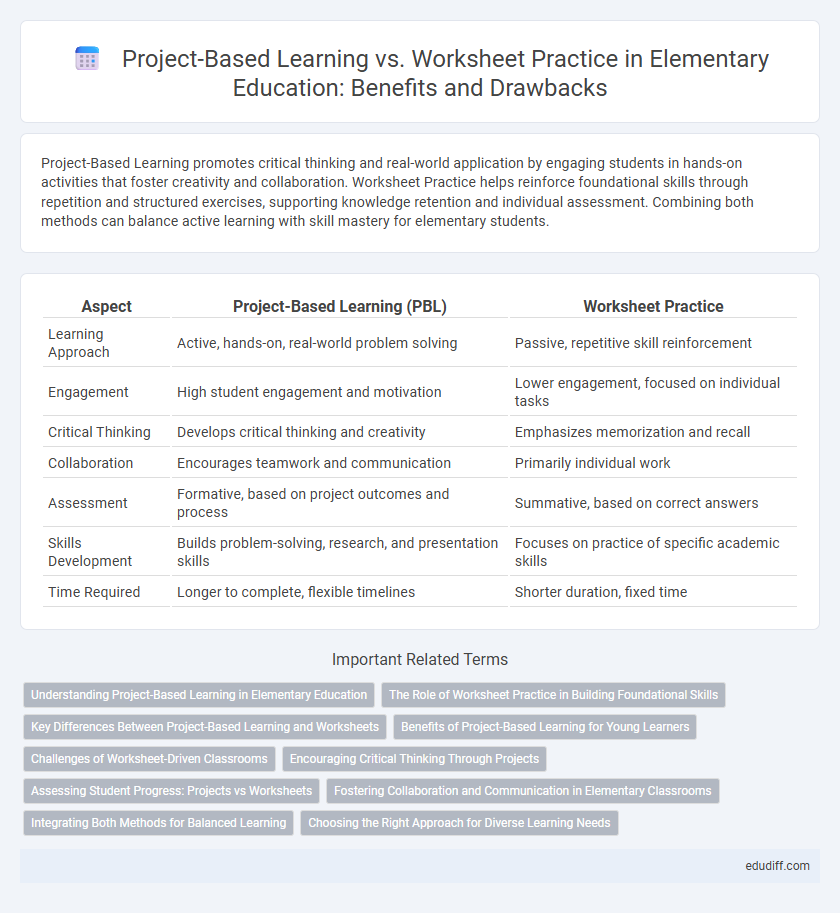Project-Based Learning promotes critical thinking and real-world application by engaging students in hands-on activities that foster creativity and collaboration. Worksheet Practice helps reinforce foundational skills through repetition and structured exercises, supporting knowledge retention and individual assessment. Combining both methods can balance active learning with skill mastery for elementary students.
Table of Comparison
| Aspect | Project-Based Learning (PBL) | Worksheet Practice |
|---|---|---|
| Learning Approach | Active, hands-on, real-world problem solving | Passive, repetitive skill reinforcement |
| Engagement | High student engagement and motivation | Lower engagement, focused on individual tasks |
| Critical Thinking | Develops critical thinking and creativity | Emphasizes memorization and recall |
| Collaboration | Encourages teamwork and communication | Primarily individual work |
| Assessment | Formative, based on project outcomes and process | Summative, based on correct answers |
| Skills Development | Builds problem-solving, research, and presentation skills | Focuses on practice of specific academic skills |
| Time Required | Longer to complete, flexible timelines | Shorter duration, fixed time |
Understanding Project-Based Learning in Elementary Education
Project-Based Learning in elementary education enhances critical thinking and problem-solving by engaging students in real-world tasks that promote deep understanding. Unlike traditional worksheet practice that often emphasizes rote memorization, project-based approaches foster collaboration, creativity, and application of knowledge across subjects. This method supports development of communication skills and active learning, essential for foundational academic growth in young learners.
The Role of Worksheet Practice in Building Foundational Skills
Worksheet practice plays a crucial role in developing foundational skills such as handwriting, number recognition, and basic grammar for elementary students. Targeted exercises help reinforce essential concepts through repetition, supporting memory retention and skill mastery. These activities complement project-based learning by providing structured practice to build competence before applying knowledge in complex tasks.
Key Differences Between Project-Based Learning and Worksheets
Project-Based Learning (PBL) emphasizes hands-on, real-world problem solving that fosters critical thinking and collaboration, whereas worksheet practice typically involves repetitive exercises focused on memorization and individual skills reinforcement. PBL encourages deeper understanding through extended exploration and application of concepts, while worksheets often target specific skills with immediate feedback. The key difference lies in PBL's holistic, student-driven approach compared to the structured, teacher-directed nature of worksheet activities.
Benefits of Project-Based Learning for Young Learners
Project-Based Learning (PBL) enhances critical thinking, creativity, and collaboration skills in young learners by engaging them in real-world problems. Unlike worksheet practice, PBL encourages active participation and deeper understanding of concepts through hands-on activities. This approach fosters motivation and retention, making learning meaningful and enjoyable for elementary students.
Challenges of Worksheet-Driven Classrooms
Worksheet-driven classrooms often limit critical thinking and creativity, as students focus on completing tasks rather than understanding concepts. This approach restricts opportunities for collaboration and hands-on exploration, which are essential for deeper learning. Consequently, engagement and motivation can decline, making it harder for students to develop problem-solving skills.
Encouraging Critical Thinking Through Projects
Project-based learning fosters critical thinking by engaging elementary students in real-world problem-solving tasks that require analysis, creativity, and decision-making. Unlike worksheet practice, which often emphasizes memorization and repetition, projects encourage students to explore concepts deeply and apply knowledge in meaningful contexts. This hands-on approach improves critical thinking skills by promoting inquiry, collaboration, and reflection.
Assessing Student Progress: Projects vs Worksheets
Project-based learning offers a dynamic way to assess student progress by showcasing skills through real-world applications, critical thinking, and creativity. Worksheets primarily evaluate memorization and basic understanding but may not accurately reflect deeper comprehension or problem-solving abilities. Combining both methods can provide a more comprehensive view of student learning outcomes in elementary education.
Fostering Collaboration and Communication in Elementary Classrooms
Project-Based Learning (PBL) promotes collaboration and communication by engaging elementary students in group tasks that require shared problem-solving and active dialogue. Unlike worksheet practice, which often emphasizes individual work and rote skills, PBL encourages students to discuss ideas, negotiate roles, and present their findings collectively. This interactive approach develops essential social skills and deeper understanding through peer interaction and cooperative learning.
Integrating Both Methods for Balanced Learning
Integrating project-based learning with worksheet practice in elementary education enhances critical thinking and foundational skills simultaneously. Projects promote creativity and real-world application, while worksheets reinforce core concepts and procedural fluency. Combining these methods fosters balanced development, catering to diverse learning styles and improving overall academic performance.
Choosing the Right Approach for Diverse Learning Needs
Project-Based Learning (PBL) fosters critical thinking and creativity by engaging elementary students in hands-on, real-world tasks that cater to diverse learning styles. Worksheet practice offers structured skill reinforcement, ideal for mastering foundational concepts and providing immediate feedback. Selecting the right approach depends on individual student needs, balancing active exploration with focused practice to optimize learning outcomes.
Project-Based Learning vs Worksheet Practice Infographic

 edudiff.com
edudiff.com